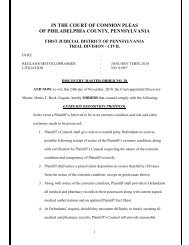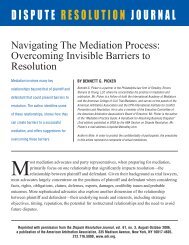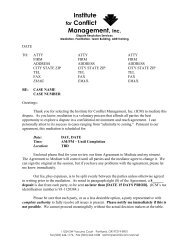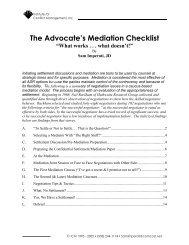Collaborative Problem Solving: An Effective ... - Mediate.com
Collaborative Problem Solving: An Effective ... - Mediate.com
Collaborative Problem Solving: An Effective ... - Mediate.com
Create successful ePaper yourself
Turn your PDF publications into a flip-book with our unique Google optimized e-Paper software.
<strong>Collaborative</strong> <strong>Problem</strong> <strong>Solving</strong>: <strong>An</strong> <strong>Effective</strong> Approach For Managing ConflictIn The WorkplaceJ. Stuart Ablon and Seth BernsteinAbstract<strong>Collaborative</strong> <strong>Problem</strong> <strong>Solving</strong> (CPS) is a method of conflict resolution that wasoriginally developed for working with very difficult children. However, CPS is not justfor kids. It is an evidence based practice that can be adapted for use in helpingmanagers to work effectively with their staff when, inevitably, conflict arises. Thecore of CPS is “Plan B,” a clear, multi-step process for working through conflict. Thisarticle describes the conceptual underpinnings of CPS and provides directions,illustrated by examples, for executing Plan B.
<strong>com</strong>prehensive approach for working with difficult children (Green, R. 2001; Green,R. & Ablon, S., 2006) has been widely disseminated through seminars andworkshops offered throughout the United States.As more people have learned CPS, it has been applied in an increasingly widerange of settings with diverse populations and provocative results. Its effectivenesshas been demonstrated everywhere from homes and schools to residentialtreatment facilities, hospitals and even corrections facilities. We have found thisapproach to be coherent, accessible, and applicable to the workplace setting.The CPS PhilosophyIt is essential for the managers to establish an expectation among themselves andwith their staff that conflict will be handled in a consistent manner. Managers alsoneed to have and to <strong>com</strong>municate a clear philosophy of conflict management. Theoriginal philosophy of CPS is that “kids do well if they can. If they can’t, we adultsneed to figure out why, so we can help.” Translated into the workplace, this reads,“staff do well at their jobs if they can. If they can’t, managers need to help themfigure out why, so they can.”The CPS philosophy informs us that the manager’s explanation of a staff’s behavior,attitude, etc. will guide his or her intervention with that staff member. Conventionalwisdom tells the manager that staff’s challenging behavior is usually designed to getthings or avoid things, such as getting attention or avoiding work. Flowing from aconventional explanation like this, a conventional response to such behavior wouldbe to ignore it or try to motivate more <strong>com</strong>pliant behavior. There certainly is a logic toconventional wisdom and some value to the conventional response if conventionalexplanations are correct. Staff generally do respond to consistent rewards andpunishments and also to being ignored (which is a form of punishment). Theseapproaches can work. They just don’t work as effectively in most situations as atransparent, systematic, and collaborative method of conflict resolution. <strong>An</strong>d theydefinitely don’t tend to work in the most challenging of circumstances and can in factbe counterproductive.The CPS Approach To Managing ConflictWhen presented with conflict or an expectation that a staff member is not meeting,managers generally have three choices: Plan A: impose their will; Plan B:collaborative problem solving; Plan C: drop the issue, at least for now.Which option managers chose depends on the long term and short term goalsmanagers have with individual staff; how far along they and their staff are in realizingthose goals; and the situation/problem at hand. As managers <strong>com</strong>e to know moreabout each of these Plans and as they improve their understanding of how each of- 3 -
their staff respond to them in different situations, they will gain more confident inwhich Plan to chose at any given point in time.In executing Plan A, managers are exercising their prerogative as the person inauthority. This is what French and Raven (1959) refer to as “legitimate power.”There is nothing inherently wrong with this approach. Sometimes it represents theshortest distance between two points. Sometimes staff really want their manager tomake an executive decision and get on with it rather than take the time needed toarrive at a consensus.More often, Plan A is experienced by staff in the same way they experienced aparent saying, “because I said so.” Staff may <strong>com</strong>ply because there was no realchoice, but they remain angry and consequently find passive ways to resist.Managers, may be able to tell themselves, “my staff did what I told them to do”, but itis highly likely that the situations which required the boss to give these orders willkeep popping up. Plan A can be effective; it can also be risky and unproductive. Itrarely solves tough problems in durable ways. It certainly does not teach staff theskills that would be needed to resolve such issues in the future without theintervention of their managers. It definitely does not build the kind of collaborativerelationships that are key to effective management in organizations that requiregroup problem solving to succeed.Plan C has obvious advantages. “Pick your battles” is sage and time-tested advice,but that there is a significant downside to this strategy. Managers are likely to feelthat when they execute Plan C they will be viewed by staff as dodging the issue orcapitulating. They might then be concerned that their staff, in observing theirmanagers avoid a conflict, will be emboldened to continue with this behavior. Toexecute Plan C properly, the manager must recognize that Plan C is not giving in. Itis a well thought out decision. What is giving in? A failed Plan A leading to Plan C! Inother words, the manager tries to make staff do something, it does not occur, andthen the manager drops the expectation. The key to using Plan C successfully is toonly use it tactically. Managers use it when they have reasoned that a particularconflict is not worth the time it will take to effectively work it through; because thetiming is not right for dealing with the issue; or simply because they or theirorganizations have bigger fish to fry for the moment.Plan B is the middle way. Plan B is the heart and soul of CPS: it is collaborativeproblem solving. At the end of a successfully executed Plan B the manger can say tohim or herself, “we worked it out. We solved the problem…..together.” ObviouslyCPS did not invent the idea that people at different levels of authority can jointlywork out their problems. What CPS does exceptionally well is to describe a series ofresearch-based and easily understandable steps for ac<strong>com</strong>plishing this goal.- 4 -
Plan BOur description of Plan B below differs somewhat from how Plan B is described inworking with challenging kids. The modifications to Plan B flow from our experienceapplying it in the workplace. Plan B consists of two phases. In the first phase, themanager and staff member form a collaborative relationship. They take turnsworking towards a mutual definition of their problem. This definition serves as thebasis for entering into the second phase, which is negotiation and problem solving.The first phase generally takes a lot longer than the second. It’s a lot like painting aroom in a house. To paint well, two-thirds of the time needs to be spent prepping.Only one-third of the time will actually be devoted to applying the paint. The sameholds true for two people trying to solve a problem . It is the “prep work” that makesthe difference between an effort that lasts and one that just buys a little time until thenext conflict. Although the first phase of Plan B is broken into three steps, it is oftennecessary to go back and forth between steps to <strong>com</strong>plete this prep work. Plan Bshould be thought of as a process, not a technique.When Plan B is executed after careful thought has been given, it is called ProactivePlan B. However, sometimes situations quickly arise and it is not possible to take thetime to thoughtfully develop a Plan B. The situation demands that the managerresponds immediately. When managers apply the principles of CPS on the fly,without a clear plan, this is called Emergency Plan B. It is less likely to be effectivethan Proactive Plan B, but it is much more likely to be effective than trying torespond to a conflict in the moment without a set of guiding principles. Since chronicproblems with staff not meeting expectations in the work place are quite <strong>com</strong>mon,managers who are skilled in using CPS will rarely need to use Emergency Plan Bwith staff they have <strong>com</strong>e to know. Rather, they will have planned, proactiveconversations with staff to develop an approach together that they can then usewhen the need arises in the future.A general point to note: managers should avoid being sucked into managing conflictwhen emotions are raw. Take the initiative. Pick the time and place to implementProactive Plan B following the steps described below. This will yield the best results.First Phase: Form A <strong>Collaborative</strong> Relationship <strong>An</strong>d Mutually Define The <strong>Problem</strong>Step 1: Empathize with staff’s view of the situation and define the problem from theirpoint of view. This step is <strong>com</strong>plete when the manager has received explicitconfirmation from staff that they have been heardThis is the most crucial Step of Plan B. The temptation will be for managers to statetheir point of view first. This temptation must be resisted. Let staff go first. To do- 5 -
otherwise makes it highly likely that Plan B will fail. Start with a brief, neutralobservation. Then STOP and LISTEN.The manager’s objective in Step 1 is to make a simple, clear, and indisputably factbasedstatement that can serve as the starting point for discussion. It is NOT astatement of the problem. It is an objective statement regarding a situation or astatement regarding what the manager felt in a specific situation. Such a statement,followed by silence, creates a “space” that allows staff to initiate a conversation fromtheir perspective. In Step 1 the manager does not <strong>com</strong>municate a perspective. Themanager's goal is to initiate a conversation from the perspective of a neutralobserver and then to gather information. The goal is to understand the staffmember’s concerns or perspective about a given problem in as specific a fashion aspossible.Here are some examples of an opening neutral observation. Readers will befollowing the manger’s discussions with Mary, and Jim for the remainder of thisarticle.Mary, the next thing I’d like to talk about in supervision is an interaction wehad last week. When we started talking about your sales targets for next yearit seemed like you had a reaction to what I said. Could you fill me in a bit onhow this conversation went for you? Jim, I've noticed that you rarely drop by my office my office anymore to catchme up on what you are working on or to ask for my advice. . The beauty of simply making a neutral observation and then listening to a staffmember's response is that at least 50% of the time, when this is done properly,managers discover that the feelings and perceptions that led them to believe therewas a problem were, in fact, inaccurate. Finding out there really is no problemspares managers and their staff the time and trouble of working through a conflictthat is non-existent. It spares the manager from having had an interaction with thatmade them look foolish. <strong>An</strong>d if there is a problem, the manager often end up beingsurprised to learn that staff’s concerns were different than they assumed.However, when staff’s response to the manager’s neutral observation confirms thatthere is indeed a conflict or a problem, the manager needs to continue with Step 1.This involves a process of drilling down, using questioning, reflective listening,educated guessing, and providing reassurance until staff's viewpoint is clearlyunderstood and stated in a manner that results in their saying, “yes, you've got thatright.”The technique of reflective listening was developed by Carl Rogers (1951, 1961),who established an evidence-based approach to counseling that was based called- 6 -
Proactive Plan B provides the opportunity to carefully prepare a statement of concernsand to practice stating them. Writing them down prior to discussion is very helpful. It iseven more helpful to say them out loud, either in a private space or to a peer orsupervisor. (It is not necessary to “name names” to get useful feedback.) Hearingconcerns stated out loud often makes it clear whether or not the manager has alegitimate concern and if that concern rises to a level that it needs to be talked about.Managers do not live in a perfect world and do not have the time to resolve everyconflict that occurs. Managers need to be strategic in deciding which conflicts merit thislevel of effort. If staff are exhibiting an ongoing pattern of behavior that significantlyimpact their work and/or the work of their coworkers (including their own managers),taking the time to think through and implement Plan B will be a valuable investment ofthe manager’s time and energy.Here are some examples of Step 2, which build on the examples provided above.Mary, my concern is that our department’s sales figures have not been meetingtarget for the past two quarters, yours included. I want to be helpful to you infiguring out what you can do to turn things around. During supervision I take outyour sales figures so that we can monitor how our efforts are working. Havingthis data in front of me when I talk with my boss is useful to me and to her, butperhaps you are not finding this to be the case. If the manager thought Mary could benefit from more direction, a couple ofalternatives to the illustration above could have been “Is this making sense toyou?” or “Could you feed back to me what you hear me saying? It is important tome to know that I have been <strong>com</strong>municating my viewpoint clearly.”Jim, I am aware of all the time you put in on evenings and weekends to get thejob done. I am also aware that you have been working here longer than Bill. Ivalue your <strong>com</strong>mitment to our <strong>com</strong>pany, our department, and to me. Decidingwho this position should go to was a tough choice for me to make and I dobelieve you could have done the job. This was a situation where there were twoqualified people and I had to chose the person I thought could do the job best atthis point in time with the particular challenges we are facing today. I amconcerned that the choice I made leaves you feeling devalued and that it seemsto have hurt our relationship. I am used to us both feeling <strong>com</strong>fortable when weare working together. It does not feel that way to me now and that concerns me.It would have been tempting for the manager to say, “you seem to be angry andupset” or “I am responding to your dis<strong>com</strong>fort with me.” Both would be “youstatements” as opposed to “I statements.” The problem with “you statements” isthat they put the speaker in the position of telling the other person what he or sheis feeling. The manager cannot know that. No one likes other people telling them- 8 -
what they are feeling. When they do that, we pull away from them and disengagefrom <strong>com</strong>munication.Step 3: Invite staff to work together on solving a jointly defined problem. Obtainagreement.If a manager and staff have successfully <strong>com</strong>pleted the preceding steps, they arenow ready to create an agreement that forms the basis for solving a problem, onethat they jointly define. Step 3 is <strong>com</strong>monly initiated by a statement like this:I think you have a good understanding of my point of view and I believe I nowhave a pretty good understanding of yours. We both have concerns. Yours are and mine are . How bout we put our heads together and find a solution for theseconcerns that works for both of us?Note: stating the last sentence in the form of a question provides staff an opportunityto let the manager know whether or not they feel that they are ready to beginproblem solving. Alternative wording, using the examples from above would be:Mary, it seems that you and I view these reviews of your sales numbers quitedifferently. I would suggest we see if there isn’t some way to modify what weare currently doing, or find another way altogether to get to the same end goalof improving sales. Shall we do that?Jim, it seems we have some repair work to do here. Do you agree?If the answer received was, “yes, let’s do that”, the manager acknowledges thatthere is an agreement and then proceeds to negotiation and problem solving. Thisacknowledgment ac<strong>com</strong>plishes two very important things. First, it is a set-up forbeginning Phase 2. Second, it provides a double-check that both the manager andstaff are ready to move on. If the manager does not hear a clear “yes” to thequestion just posed or hears “no”, then the manager needs to keep working at Step3 until a clear “yes” is <strong>com</strong>municated. Only when 'yes” is heard is it time to proceedto the second phase of Plan B.Second Phase: Negotiation <strong>An</strong>d <strong>Problem</strong> <strong>Solving</strong>There is not a stepwise road map to follow for this phase of CPS. Phase 2 does notlend itself to that kind of approach. The process is more circular than linear. Thevariations are endless. However, there are some general principles for you to follow.1. Base your negotiation and problem solving activities on the specifics learnedduring Phase One.- 9 -
2. Create an opportunity for your staff and/or you to develop or enhanceinterpersonal and other skills. Brainstorming potential solutions togetherrepresents a learning opportunity for both of you.3. The solution should provide an opportunity for incremental learning. We generallylearn new skills best when they are broken into bite size pieces.4. Keep your solution(s) in your back pocket. Give your staff the first opportunity topropose a solution. Ideally, the solution will be one that is arrived atcollaboratively and does not “belong” to either individual.5. Resist turning negotiation and problem solving into a process of determining whois at fault. The natural tendency in such dialogues is to drift towards assigningblame. Neither you nor your staff are immune from this tendency.6. To the extent it is possible, frame your discussion of the problem at hand in sucha way that the solutions you both arrive at and the problem solving skills yourstaff develops can be generalized to other situations.Here are some examples of how negotiation and problem solving might go followingthese principles. The dialogue picks up where it left off, above. The manager hasproposedMary: Yes, I’m really worn out by what we’ve been doing. I dread supervision andour endless discussion of my sales figures. To tell you the truth, I’ve beenthinking about working somewhere else and have updated my resume. I’d rathernot leave if I don’t have to. Until my sales took a nose dive, I liked working hereand I liked working with you.Manager: Then lets see if we can find an approach that is helpful to you. I wantyou to succeed. I’ve heard your concerns about the pressure you feel from ourweekly review of sales figures and you have heard my concerns about meetingour sales targets. What are your thoughts about how we can solve our dilemma?Mary: Isn’t that your job to figure out?Manager: No. It’s our job.Mary: Manager: Mary: Hmmm. Well, maybe if I got the most recent sales figure before I came tosupervision that would be helpful.Manager: Sure, you could review them before hand. There would be nosurprises. I like it,- 10 -
Mary: <strong>An</strong>d I could do my own analysis ahead of time. I wouldn’t be forced to havean instant answer about how I’m going to get everything fixed.Manager: If I got the report to you at least two days before our weekly meetingwould that work for you?Mary: Yes.Manager: <strong>An</strong>d would it work even better for you if we met every other weekrather than weekly? I do feel a need to stay on top of this situation, but perhapsI’m making matters worse by meeting with you so often.Mary: That would be a lot better. Thanks. I had been thinking about that, butthought you’d never go for it. This is a pleasant surprise.The manager in this illustration is smart not to engage Mary about her thoughts andplans about leaving. That would be a distraction from an effort to help her succeed ather current job. So, the manager presses ahead, asking Mary if she has any ideasabout how to solve the problem, which is carefully framed as “our dilemma.” Shedoesn’t bite initially and expresses her frustration and anger at her boss throughsilence. The manager wisely lets the silence be and does not rush in to fill it, whichwould deprive Mary of the opportunity to express herself through words. Withpatience, this happens.Once Mary feels that it safe to do so – the conversation moves very quickly into aproblem solving mode. The solutions were not hard to <strong>com</strong>e by. They rarely are. It isthe preconditions for problem solving that are the challenge. Note that the managergets swept into the spirit of problem solving too. When Mary “gives” a little, takes arisk and offers an idea, the manager feels inclined to give a little too. His idea tochange the frequency of his oversight is not just an intellectual “ah-ha”, it is aproduct of openness being matched by openness. It is an openness not just to newideas, but to self-reflection and taking responsibility. His real “ah-ha” is an emotionalrecognition that he had been just as stubborn and uncreative as Mary. Havingfollowed Plan B, both Mary and her manager have succeeded in breaking throughthat ice, allowing their working relationship to get back on track. The manager wasmanaging once again in a way that he could feel good about and Mary was feelingsome hope that supervision with her boss could help her figure out how to succeedat her job.Jim: I’ve been in this position now for four years. The one that you just gave toBill is the only one I saw as an opportunity for advancement. My wife is in adead-end job too and we’ve got a second kid <strong>com</strong>ing in March.- 11 -
Manager: So, I’m hearing that in addition to your feeling devalued by my hiringchoice, you’re feeling a lot of pressure to be earning more.Jim: Yeah, that’s for sure.Manager: That helps me understand the tension I’m feeling between us. Are youwanting to work on this together or are you thinking that working elsewhere mightbe a better option for you?Jim: I’ve thought about that, but I’d rather have this job work out. I basically likeworking here.Manager: You like working here, but need to see a path to advancement andincreased earning. I had a tough choice to make and made it; I had no intent todevalue your work, though I understand how it felt that way to you. Should weput our heads together and see what ideas we can <strong>com</strong>e up with that addressboth of our concerns?Jim: Hmmmm. I guess so.Manager: What are you thinking might helpful?Jim: I need to see a way for me to be making more money. Maybe in the shortrun it doesn’t have to be a new position. Is there some other way?Manager: It occurs to me that there might an opportunity for you to do somespecial projects that are outside the scope of your current position. They could bedone on weekends if you are open to that. But <strong>com</strong>e to think of it, we have notreviewed your job description in quite awhile. It seems to me that there is adisconnect between your current level of responsibilities and what your jobdescription says. If that is the case, <strong>com</strong>pany policy allows me to adjust yoursalary. If either of these approaches is possible, does it sound like a solution toyou? Would you be feeling differently about working with me?Jim: Yes and yes. Thanks.It is clear from Jim saying, “yeah, that’s for sure” that the manager made an error inhis initial execution of Plan B. His expression of empathy (Step 2) was inadequatebecause it was in<strong>com</strong>plete. It only addressed the devaluation Jim felt when hismanger awarded the new position to Bill rather than to him. Jim had not told themanager, nor was the manager able to discern the monetary pressure he wasunder. Until Jim heard from his manager that he understood this aspect of hisdilemma, he was not ready to hear what the manager’s concerns were or to join himin problem solving. Second, the manager had proceeded to problem solving withoutclearly getting agreement from Jim that he was ready or wanting to do this. So, the- 12 -
It would be a lot of work to go back and redo the steps of Plan BThe manager has generated some good will through what has been donethus far to resolve the conflictThe manager can clearly state a rationale to staff for dropping the issueThe issue is not swept under the rug. Before it is dropped, the issue is clearlystated.Staff agrees to dropping the issue for nowDropping the issue does not penalize staff<strong>An</strong>other <strong>com</strong>mon mistake in executing Plan B is the manager putting solutions onthe table instead of concerns during Step 3. Many managers are apt to rush tosolutions before hearing the concerns of others or stating their own. Managers aregenerally good problem solvers and this ability has a seductive tendency to luremanagers of both sexes to get to the “good part” quickly. This will backfire.Managers can’t rush the process and expect to succeed. Managers need to beaware that difficult problems will likely require more than one discussion and that the<strong>com</strong>plete Plan B process does not need to be <strong>com</strong>pleted in a single sitting. Finally,managers should realize that despite the best laid plans of Plan B, it is frequently anadventure. If the manager does a good job of empathic listening and detective work,additional concerns and issues may surface which may require more immediateattention than what the manager intended to discuss.When Plan B is not working, the manager should also consider a number ofpersonal factors that are independent of the manager’s execution of Plan B. It couldbe that either the manager or staff are under severe stress. Perhaps the manager isworking with a staff member who is more <strong>com</strong>fortable with a Plan A approach than aPlan B approach. It is essential for managers to adapt their approach to theindividual they are working with.ConclusionThis is hard. CPS is not conceptually difficult to master, but putting it to use takeslots of practice and perseverance. There will be successes and setbacks. Managersshould keep these points in mind as they make the effort to translate the conceptsand procedures into a useful skill set.Early on, CPS can feel unnatural, but over time, a Plan B “rhythm” shoulddevelopVery difficult problems may require more than one discussion.Sometimes it’s necessary to take a break from the discussion and return to itlater, after both parties have had time to think separately about what hasbeen said.The first solution seldom solves the problem durably.- 14 -
Just talking with staff about an issue is not the same thing as doing Plan B.Plan B is a very particular kind and sequence of talking.Our experience, and the experience of thousands of people who use CPS is thatcollaborative problem solving provides people of diverse backgrounds and a widerange of interpersonal abilities an easy to understand, straight-forward method ofworking through conflicts. It does take time (which translates into money), but theinvestment will pay for itself many times over when managers experience first handhow much more productive their teams are when a Plan B culture is established.- 15 -
ReferencesAblon, S., Edwards, G., Green, R., Goring, J., Henin, A., Markey, J., Monuteaux, M.,Rabbitt, S., Reazer-Blakely, L., (2004). <strong>Effective</strong>ness of <strong>Collaborative</strong> <strong>Problem</strong><strong>Solving</strong> in Affectively Dysregulated Children With Oppositional-Defiant Disorder:Initial Findings. Journal of Consulting and Clinical Psychology Vol. 72, No. 6, 1157–1164.Deutsch, M. & Coleman, P. (Eds.) 2000. The Handbook of Conflict Resolution:Theory and Practice. Jossey-Bass Publishers. San Francisco.French, J. R. P., Raven, B. 1959. The Bases Of Social Power. In D. Cartwright andA. Zander. Group Dynamics.: Harper & Row,. New YorkGoleman, D., 1998. Working With Emotional Intelligence. Bantam Books. New York:Green, R. (2001). The Explosive Child: A New Approach for Understanding andParenting Easily Frustrated, Chronically Inflexible Children. HarperColins. New York.Green, R. & Ablon, S (2006). Treating Explosive Kids: The <strong>Collaborative</strong> <strong>Problem</strong><strong>Solving</strong> Approach. The Guildford Press. New York.Green, R.,Ablon, S., & Martin, A. (2006). Use Of <strong>Collaborative</strong> <strong>Problem</strong> <strong>Solving</strong> toReduce Seclusion and Restraints in Child and Adolescent Inpatient Units.Psychiatric Services. Vol 57, No 5. May.Jordan, P & Troth, A. 2004. Managing emotions during team problem solving:Emotional intelligence and conflict resolution. Human Performance 17(2): 195–218.Jordan, P. & Troth, A. 2006. Emotions and Coping With Conflict: <strong>An</strong>Introduction. Journal Of Management & Organization Volume 12, Issue 2,September.Martin, A., Mohr, W., Olson, J., & Pumariega, A. 2009. Beyond Point and LevelSystems: Moving Toward Child-Centered Programming. American Journal ofOrthopsychiatry. Vol. 79, No. 1, 8–18.Rogers, C. 1951. Client-Centered Therapy: Its Current Practice, Implications <strong>An</strong>dTheory. London, Constable.Rogers, C. 1961. On Be<strong>com</strong>ing a Person. London, Constable.Wilmot, W. & Hocker, J. 2001. Interpersonal Conflict.. McGraw-Hill, New York.- 16 -


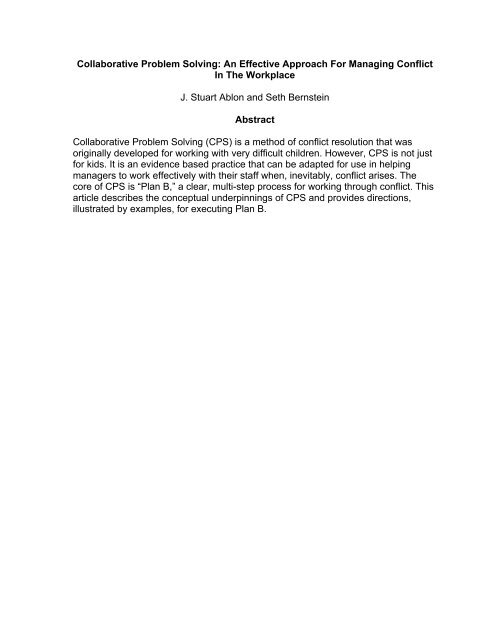
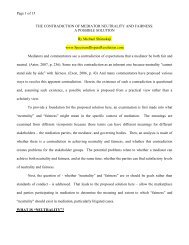

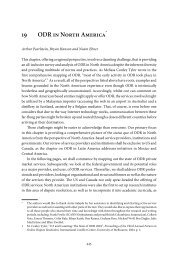
![Settlement Agreement Form [Agreement] - Mediate.com](https://img.yumpu.com/50682143/1/190x245/settlement-agreement-form-agreement-mediatecom.jpg?quality=85)


